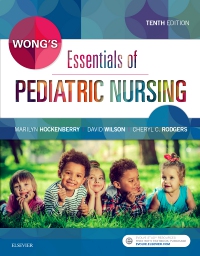
Wong's Essentials of Pediatric Nursing - Elsevier eBook on VitalSource, 10th Edition
Elsevier eBook on VitalSource

Awarded first place in the 2017 AJN Book of the Year Awards in the Child Health category. Known for its accuracy, evidence-based focus, and engaging writing style, Wong’s Essentials of Pediatric Nursing, 10th Edition has been the #1 title in the pediatric nursing market since it first published in 1980! Thoroughly revised to equip your students with the latest research and guidelines for treating children today, it encourages a whole-body approach by beginning with child development and health promotion to better understand the later chapters on specific health problems. A new chapter featuring all systems cancers provides comprehensive information in one place. Nursing Care Plans now incorporate additional case studies to personalize interventions and promote critical thinking.
Newer Edition Available
Wong's Essentials of Pediatric Nursing - Elsevier eBook on VitalSource
-
- NEW! Updated content throughout, notably methods of measuring competency and outcomes (QSEN and others), ambiguous genitalia, pediatric measurements, guidelines, and standards as defined by the American Academy of Pediatrics, and clear definitions of adolescent and young adult, keeps students up-to-date on important topic areas.
- NEW! The Child with Cancer chapter includes all systems cancers for ease of access.
- NEW and UPDATED! Case Studies now linked to Nursing Care Plans to personalize interventions for students, while also providing questions to promote critical thinking.
- Updated genetic content in the Developmental and Genetic Influences on Children chapter addresses rapidly changing and important information as it relates to children in health and illness.
- UNIQUE! Critical thinking case studies allow students to test and develop their analytical skills in a variety of clinical situations.
- UNIQUE! Quality Patient Outcomes content in Nursing Care Management discussions for major diseases and disorders helps students understand how the care they provide directly impacts patient safety and promotes positive outcomes.
- Drug Alerts throughout the text emphasize important drug information and point out potential safety issues.
- A developmental approach clearly identifies key tasks, influences, and differences at each stage of a child’s growth to help students provide appropriate, individualized care for each child.
- An emphasis on wellness offers health promotion and injury prevention strategies for each age group.
- UNIQUE! Family focus includes a separate chapter on the role of the family in child health, family content throughout the text, and Family-Centered Care boxes that highlight information on patient teaching, home care, and incorporating the family in the child's care.
- Community Focus boxes provide resources and guidance on caring for children outside the clinical setting.
- UNIQUE! Translating Evidence into Practice boxes focus students’ attention on the application of research and critical thought processes to support and guide the outcomes of nursing care.
- Nursing Care Plans, including Nursing Diagnoses, Patient/Family Goals, Nursing Interventions/Rationales, and Expected Outcomes, provide students with a model for planning patient care.
- Research Focus boxes help students remain abreast of current studies that impact pediatric nursing today.
- Cultural content, integrated throughout the text and highlighted in Cultural Considerations boxes, exposes students to customs and beliefs of different cultures that influence child care, enhancing their ability to provide quality nursing care to ALL children and their families.
- UNIQUE! Atraumatic Care boxes guide students through performing procedures in a caring manner, promoting more positive experiences for children, families, and nurses.
- Nursing Tips throughout the text offer helpful hints and practical, clinical information of a non-emergency nature.
- Nursing Alerts throughout the text provide students with critical information that MUST BE considered in providing care.
- UNIQUE! Emergency Treatment boxes serve as a quick reference in critical situations.
- Nursing Care Guidelines boxes provide students with clear, step-by-step, detailed instructions for performing specific skills or procedures.
-
- NEW! Updated content throughout, notably methods of measuring competency and outcomes (QSEN and others), ambiguous genitalia, pediatric measurements, guidelines, and standards as defined by the American Academy of Pediatrics, and clear definitions of adolescent and young adult, keeps you up-to-date on important topic areas.
- NEW! The Child with Cancer chapter includes all systems cancers for ease of access.
- NEW and UPDATED! Case Studies now linked to Nursing Care Plans to personalize interventions, while also providing questions to promote critical thinking.
-
1. Perspectives of Pediatric Nursing
2. Family, Social, Cultural, and Religious Influences on Child Health Promotion
3. Developmental and Genetic Influences on Child Health Promotion
4. Communication and Physical Assessment of the Child and Family
5. Pain Assessment in and Management in Children
6. Infectious Disease
7. Health Promotion of the Newborn and Family
8. Health Problems of Newborns
9. Health Promotion of the Infant and Family
10. Health Problem of Infants
11. Health Promotion of the Toddler and Family
12. Health Promotion of the Preschooler and Family
13. Health Problems of Toddlers and Preschoolers
14. Health Promotion of the School Age Child and Family
15. Health Promotion of the Adolescent and Family
16. Health Problems of School Age Children and Adolescents
17. Quality of Life for Children Living with Chronic or Complex Diseases
18. Impact of Cognitive or Sensory Impairment on the Child and Family
19. Family-Centered Care of the Child During Illness and Hospitalization
20. Pediatric Variations of Nursing Interventions
21. The Child with Respiratory Dysfunction
22. The Child with Gastrointestinal Dysfunction
23. The Child with Cardiovascular Dysfunction
24. The Child with Hematologic or Immunologic Dysfunction
25. NEW! The Child with Cancer
26. The Child with Genitourinary Dysfunction
27. The Child with Cerebral Dysfunction
28. The Child with Endocrine Dysfunction
29. The Child with Musculoskeletal or Articular Dysfunction
30. The Child with Neuromuscular or Muscular Dysfunction



 as described in our
as described in our 